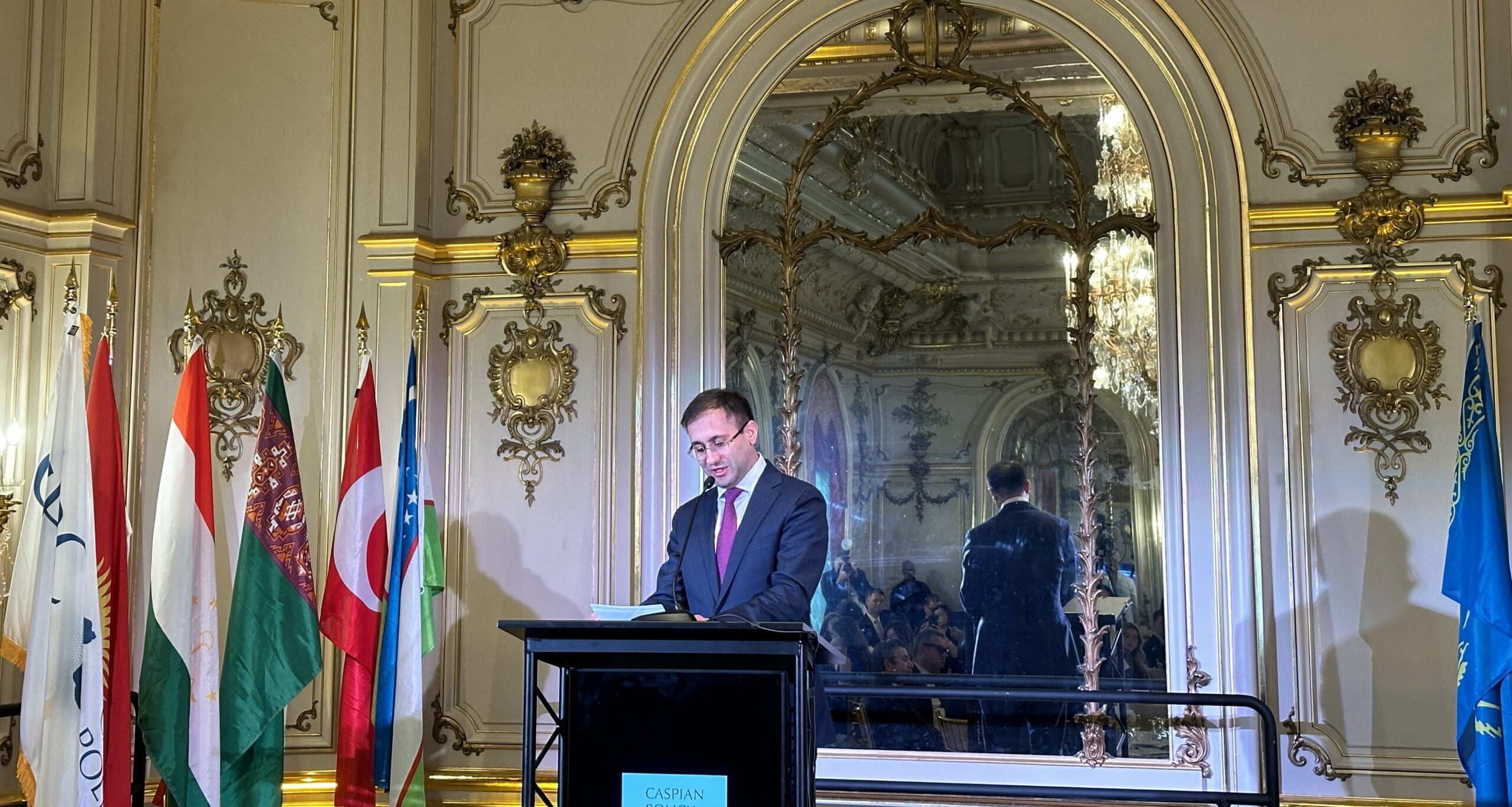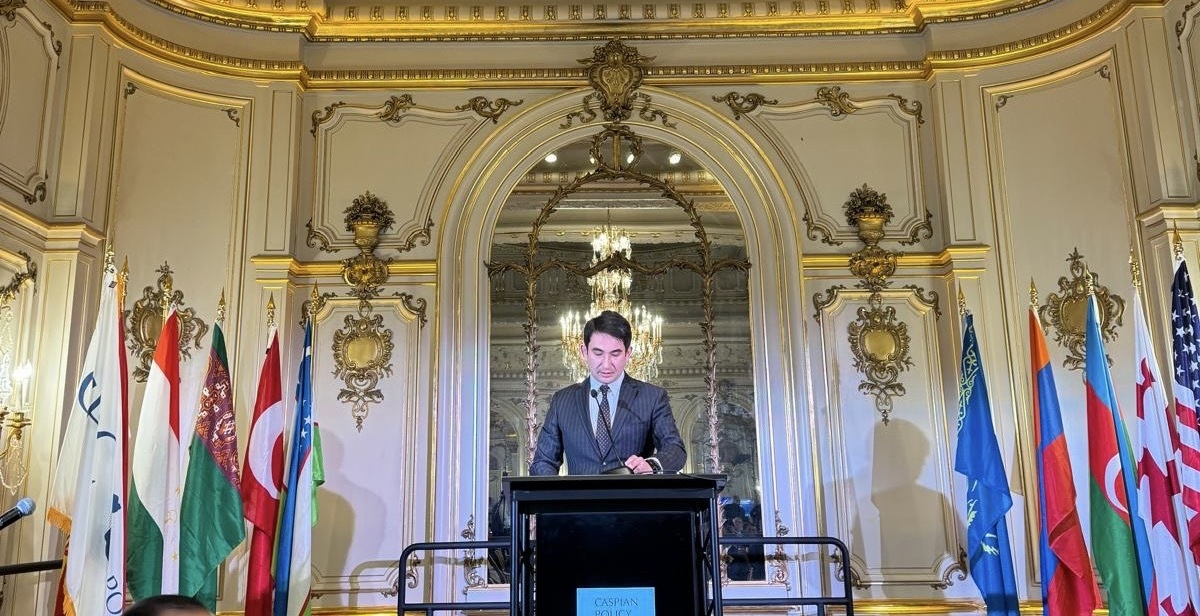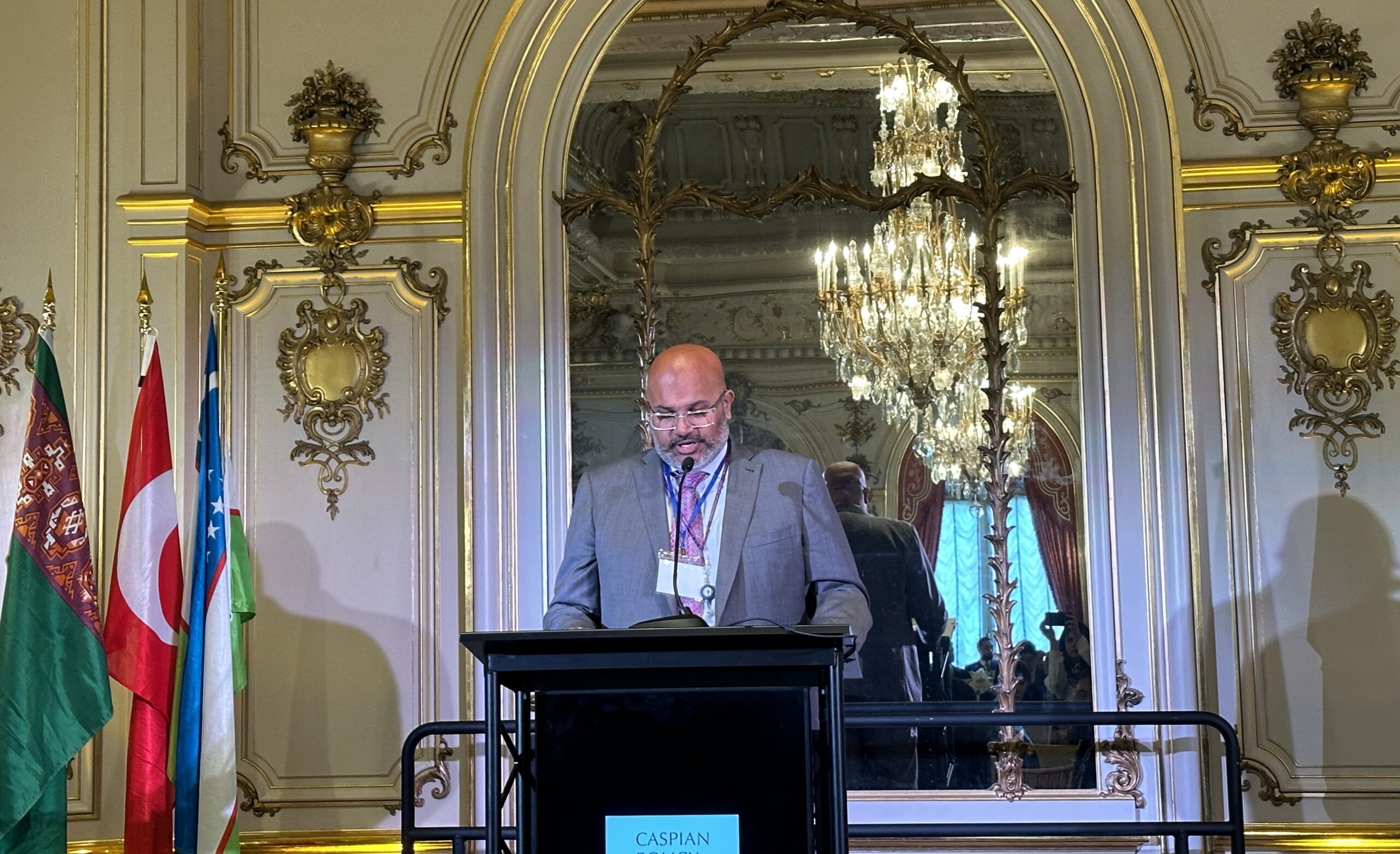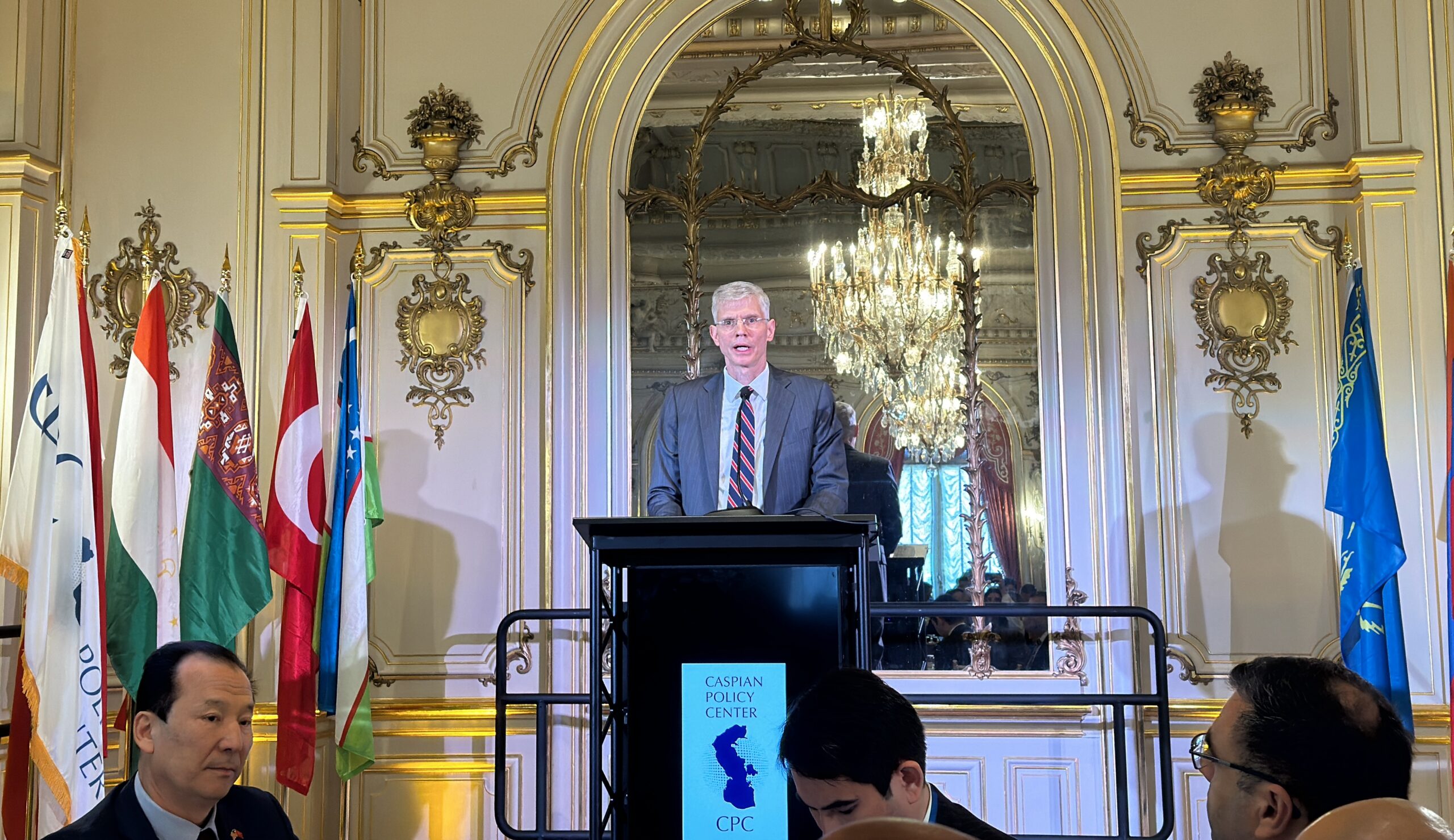ASTANA – The Caspian Policy Center organized the eighth Annual Trans-Caspian Forum on May 21 in Washington, D.C., to discuss the current challenges and prospects for a multi-modal Trans-Caspian International Transport Route (TITR) to maximize its capacity.

From L to R: Tamar Satterwhite from the Commercial Law Development Program; Winnie Wang from the World Bank; moderator Dr. Marsha McGraw Olive; Ambassador Erin McKee, Assistant Administrator for the Europe and Eurasia Bureau at the United States Agency for International Development (USAID); and Henrik Hololei from the European Commission. Photo credit: caspianpolicy.org
TITR is a multi-modal route that runs through China, Kazakhstan, the Caspian Sea, Azerbaijan, Georgia and further to European countries. The development of the route has been garnering growing attention, becoming increasingly vital to strengthen the region’s economic resilience and promote trade diversification.
According to data from the TITR International Association, the transportation volume along this corridor reached nearly 2.8 million tons in 2023, up from 1.7 million in 2022. In the first quarter of 2024, the figure hit 771 million tons.

Efgan Nifti addresses the forum. Photo credit: caspianpolicy.org
Addressing the opening session, Caspian Policy Center President Efgan Nifti noted “remarkable” developments in the Caspian region in the last 12 months. These include progress in developing the Middle Corridor, reconciliation steps between Armenia and Azerbaijan, increased engagement and investment from international partners, energy transition, and the increasing significance of critical minerals.
“The need for diversification of trade routes is obvious. This has injected new momentum into the development of regional transport connectivity in Central Asia and the South Caucasus. Further support of projects such as the Middle Corridor will not only boost political and economic relations within the region but also will support regional goals for connectivity, energy diversification, and long-term development,” said Nifti.
Kazakhstan’s vision
The development of the TITR also aligns with Kazakhstan’s goal to become a transport and logistics hub.
Deputy Chief of Mission at the Kazakh Embassy in the United States Rauan Tleulin stressed the importance of the route, also known as the Middle Corridor. According to him, TITR is a strategic corridor for supplying energy resources from the region to Europe and global markets.

Rauan Tleulin from the Kazakh Embassy in the United States. Photo credit: caspianpolicy.org
“Along with oil and gas, we are focused on the transportation of common goods and critical commodities,” said Tleulin.
He spoke about Kazakhstan’s efforts to develop TITR. “Together with Azerbaijan, Georgia, and Türkiye, we also adopted a roadmap for further eliminating the so-called bottlenecks. Implementation of the agreements will allow increasing overall trade capacity to 10 million tons per year by 2025,” said the diplomat.
The roadmap, signed in November 2022, outlines the priority directions for investments and actions needed to improve the TITR. In June 2023, Azerbaijan, Georgia, and Kazakhstan agreed to create a single logistics operator.
In 2023, Kazakhstan first shipped oil via TITR, pumping it into the Baku-Tbilisi-Ceyhan pipeline under the agreement between KazMunayGas and Azerbaijan’s SOCAR oil and gas company.
Improving connectivity
Arun Venkataraman, Assistant Secretary of Commerce for Global Markets and Director General of the U.S. and Foreign Commercial Service Global Markets for the U.S. Department of Commerce, urged the gathering to focus on upgrading transport and logistical connectivity.

Arun Venkataraman. Photo credit: caspianpolicy.org
He said it goes beyond “just seaports, airports, cargo from roads and rail lines and highways, but also communications infrastructure, safety and security systems.”
“At the Department of Commerce’s International Trade Administration, it is our job to help businesses find partners overseas, meet their goals, and find solutions to help them advance those goals,” said Venkataraman.
Increased U.S. engagement benefits TITR development
The development of the corridor also benefits from increased engagement between the United States and the region, mainly Central Asia. Deputy Assistant Secretary of State for Central Asia John Mark Pommersheim said U.S. engagement with Central Asian leaders is now higher than ever.

Ambassador John Mark Pommersheim. Photo credit: caspianpolicy.org
“Our cooperation has reached a new high over the past year,” he said, stressing the importance of the declaration signed by all five Central Asian leaders and the U.S. President in September 2023.
“We have an opportunity for the U.S. government to leverage enhanced coordination among our international partners, including for the G7 and other like-minded partners working in Central Asia, to share this common goal of advancing regional connectivity and economic resilience in Central Asia and the South Caucasus,” said the American diplomat.
Outlook from beyond
Addressing the second panel of the forum, Hors Classe Adviser to the Directorate-General for International Partnerships at the European Commission Henrik Hololei said the development of TITR into a “modern, multimodal economic gateway” is one of the key projects for the European Union.
“It is in all our interests to make the corridor competitive, predictable, affordable, and sustainable,” he said.
Hololei emphasized that developing this corridor is more crucial now than ever before.
“It’s now or never for the corridor,” he said. “During the Soviet era, the corridor was purposefully not integrated. This was a policy of division, not integration. Now, however, we have an opportunity to put it right.”
In doing so, he announced that Astana would host the launch of the EU-Central Asia coordination platform in a few weeks. The platform will establish a permanent framework aimed at fostering the implementation of projects in Central Asia.
In a recent interview with The Astana Times, Hololei expressed high hopes about the route, saying it could become a game changer in Asia-Europe connectivity.
Tamar Satterwhite, senior counsel for the Commercial Law Development Program (CLDP) at the Office of the General Counsel at the U.S. Department of Commerce, drew attention to the poor coordination among countries along the corridor and investors.
“There is a lack of coordination among the donor organizations, among the countries, and specific ministries in each country. This includes lack of information sharing,” said Satterwhite.
Costs to address the bottlenecks
In its 2023 study, the European Bank for Reconstruction and Development estimated the cost of addressing hard and soft infrastructure needs of the corridor could reach 17 billion euros (US$18.4 billion).
Winnie Wang, a lead infrastructure specialist and program leader for Europe and Central Asia at the World Bank, disclosed the World Bank’s estimates. She said the cost of priority investments may reach around $7 billion.
“We see great impacts when projects are designed to address specific bottlenecks and to define the level of service. To this end, at the World Bank, we have employed a number of regional and global monitoring tools to give the corridor solutions,” said Winnie Wang.
In November 2023, the group released a study called Unlocking the Potential of the Middle Corridor, focusing on Kazakhstan, Azerbaijan, and Georgia. The study suggests measures that can transform TITR into a vital trade route.
Among the recommendations are implementing corridor-length logistics solutions for seamless operations, simplifying border crossing procedures to facilitate traffic and data exchanges, improving digital solutions and establishing a uniform system for prioritizing investments.
According to the study, with the right policies and investments, the corridor can triple trade volumes by 2030 to 11 million tons compared to 2021 levels and reduce travel time by half.


